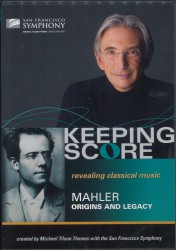 Keeping Score: Mahler - Origins and Legacy
Keeping Score: Mahler - Origins and Legacy
Michael Tilson Thomas; San Francisco Symphony
SFSMedia
This is the third season of the San Francisco Symphony’s admirable “Keeping Score” music documentary series, a project that can be followed on certain PBS stations (unfortunately Buffalo’s WNED is not among them). The episodes are typically an hour long, though the latest Mahler instalment is twice that length. The retail version of the broadcast includes a second CD featuring the complete First Symphony and isolated movements from three more symphonies (details are available at keepingscore.org). This handsomely produced and thoughtful documentary is considerably enhanced by on-location visits to Mahler’s boyhood home of Iglau (now Jihlava, in the Czech Republic) and the re-creation of its unique soundscape: a melange of military bands, the hymnody of St. Jacob’s church (Mahler, though Jewish, joined the choir there), the rustic sounds emanating from his father Bernard’s tavern, and the sylvan stillness of the ravine just beyond the town walls. Tilson-Thomas delivers an extended and quite engaging thematic analysis of Mahler’s First Symphony, convincingly demonstrating how Mahler forged the touchstone for all his subsequent works from these disparate cultural elements. Mahler’s rapid rise to the very top of his profession as a conductor is traced via stops in Budapest, Vienna and New York, including an unprecedented opportunity to enter his villa on the Wörthersee and visits to the various “composing huts” he had built for his precious few summers of composing. We learn of the genesis of most, though not all, of his 10 symphonies along the way. It is perhaps understandable, considering the huge expense of the recording contracts involved, that the choral symphonies (2 and 8) are glossed over and the grandiose 8th symphony rates but a single sentence. It is nonetheless an unfortunate omission, as both these works embrace a message of resurrection and transcendence that belie the clichéd thesis of Mahler’s introverted “otherness” which forms such a large part of Tilson-Thomas’s argument.



